
Rasters Part III: Downloading Rasters for Large Areas
Source:vignettes/rasters-pt3.Rmd
rasters-pt3.RmdIntrodution
The Cal-Adapt API is a great way to get rasters, because you can specify exactly the area you want, the climate variable(s) you want, and the time frame you want. However raster files are inherently large, and there’s an upper limit on how large of an area you get with one call. Hence we need some strategies to download and work with rasters for large areas (such as the state of California).
This vignette outlines an approach for downloading and working with rasters for large areas. The essence of the strategy is to 1) downloading rasters in a series of blocks that collectively cover the entire area-of-interest, and 2) mosaic the individual blocks to get one seamless raster. We’ll also see how you can combine multiple 3D mosaiced rasters into a single six-dimensional raster, as explained in Part 2, and use parallel processing to speed up pixelwise operations.
But first…
Downloading NetCDF Files
An alternative to downloading rasters through the API is to simply
download the source NetCDF files from the Cal-Adapt Data Server.
NetCDF files for the full extent of Cal-Adapt’s LOCA downscaled data at
a daily time scale are available for download by FTP/HTTP. You can
import NetCDF files into R using stars::read_stars() as
well as other packages. caladaptr does not provide any
functions or support for the original NetCDF data.
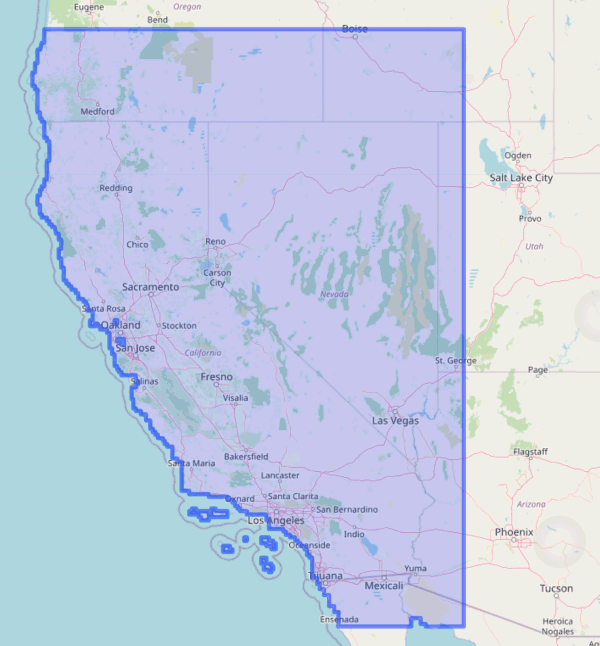
NetCDF files for the full extent of Cal-Adapt’s LOCA downscaled climate data are available for download from the Cal-Adapt Data Server
Break-up a large area-of-interest into blocks
To illustrate working with large areas, in this example we’ll download TIFs for 50 years of annual precipitation data for several scenarios and GCMs, and the entire state of California.
First load packages:
library(caladaptr)
library(dplyr)
library(sf)
library(stars)
library(magrittr)
library(tmap)
tmap_mode("plot")We begin by importing the state boundary:
ca_bnd_url <- "https://raw.githubusercontent.com/ucanr-igis/caladaptr-res/main/geoms/ca_bnd.geojson"
ca_bnd_sf <- st_read(ca_bnd_url, quiet = TRUE)
tm_shape(ca_bnd_sf) + tm_borders() + tm_grid(labels.show = TRUE, lines = FALSE)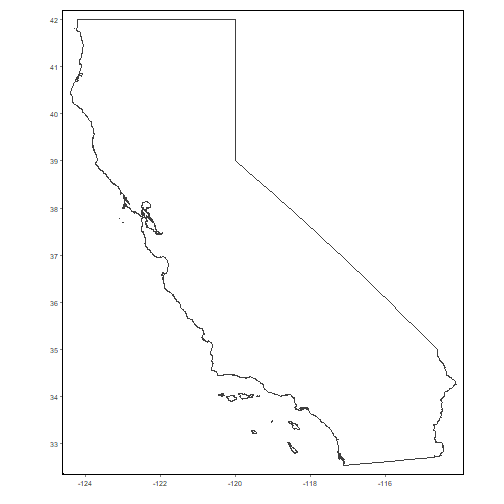
The entire state is far too big to use in an API call, but we can
break it up into blocks that are 20,000 mi2 or less using
ca_biggeom_blocks():
ca_bnd_blocks_sf <- ca_biggeom_blocks(ca_bnd_sf, block_area_mi2 = 20000)
tm_shape(ca_bnd_sf) +
tm_borders(col = "gray") +
tm_shape(ca_bnd_blocks_sf) +
tm_borders(col = "red") +
tm_text("id")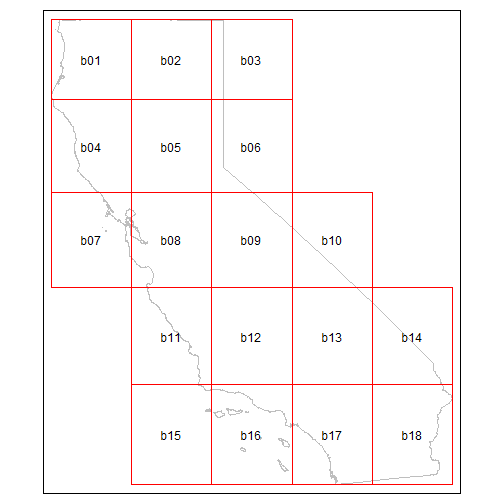
Download TIFs
The first step to download TIFs is to construct an API request. We’ll make a request for yearly precipitation totals for 50 years, 2 emissions scenarios, and 4 GCMs:
## Create a CAP
ca_pr_cap <- ca_loc_sf(loc = ca_bnd_blocks_sf, idfld = "id") %>%
ca_gcm(gcms[1:4]) %>%
ca_period("year") %>%
ca_cvar("pr") %>%
ca_scenario(c("rcp45", "rcp85")) %>%
ca_years(start = 2050, end = 2099)
ca_pr_cap %>% ca_preflight(check_for = "getrst")
#> General issues
#> - none found
#> Issues for downloading rasters
#> - none foundNext we download the TIFs by calling ca_getrst_stars().
This may take a few minutes, but we don’t have to monitor it.
TIP: A good practice when downloading large amounts of
data is to be mindful where it gets saved, and use
overwrite = FALSE so you don’t download the same raster
twice. If you’re downloading data for several projects / locations,
create a data download directory for each one so the TIFs for blocked
areas don’t get mixed up.
data_dir <- tools::R_user_dir("caladaptr", which = "data")
ca_pryr_dir <- file.path(data_dir, "ca_pr-year") %>% normalizePath(mustWork = FALSE)
if (!file.exists(ca_pryr_dir)) dir.create(ca_pryr_dir, recursive = TRUE)
ca_pryr_tifs <- ca_pr_cap %>%
ca_getrst_stars(out_dir = ca_pryr_dir, mask = TRUE, quiet = TRUE,
normalize_path = TRUE, overwrite = FALSE)
ca_pryr_tifs %>% basename() %>% str()
#> chr [1:144] "pr_year_HadGEM2-ES_rcp45_id-b01.tif" "pr_year_CNRM-CM5_rcp45_id-b01.tif" "pr_year_CanESM2_rcp45_id-b01.tif" ...Import TIFs and mosaic them
After you’ve downloaded TIFs in blocks, the next step is to use
ca_stars_read() to import them in R as list of stars
objects:
ca_pryr_blcks_stars_lst <- ca_pryr_tifs %>%
ca_stars_read()
length(ca_pryr_blcks_stars_lst)
#> [1] 144
names(ca_pryr_blcks_stars_lst) %>% head(20)
#> [1] "pr_year_HadGEM2-ES_rcp45_id-b01" "pr_year_CNRM-CM5_rcp45_id-b01" "pr_year_CanESM2_rcp45_id-b01" "pr_year_MIROC5_rcp45_id-b01"
#> [5] "pr_year_HadGEM2-ES_rcp85_id-b01" "pr_year_CNRM-CM5_rcp85_id-b01" "pr_year_CanESM2_rcp85_id-b01" "pr_year_MIROC5_rcp85_id-b01"
#> [9] "pr_year_HadGEM2-ES_rcp45_id-b02" "pr_year_CNRM-CM5_rcp45_id-b02" "pr_year_CanESM2_rcp45_id-b02" "pr_year_MIROC5_rcp45_id-b02"
#> [13] "pr_year_HadGEM2-ES_rcp85_id-b02" "pr_year_CNRM-CM5_rcp85_id-b02" "pr_year_CanESM2_rcp85_id-b02" "pr_year_MIROC5_rcp85_id-b02"
#> [17] "pr_year_HadGEM2-ES_rcp45_id-b03" "pr_year_CNRM-CM5_rcp45_id-b03" "pr_year_CanESM2_rcp45_id-b03" "pr_year_MIROC5_rcp45_id-b03"TIP: Monitoring memory usage. The default mode of importing stars objects is for them to be read into memory. Depending on the size of your study area, the number of layers, and the amount of RAM in your computer, this can potentially consume a lot of memory, and in extreme cases slow your computer to a crawl.
There are several packages you can use to monitor how much memory
different R objects are using. To see how much memory an object is using
with base R, you can run
object.size(x) %>% format(units = "Mb").
If your stars objects are too big for memory, you can be selective about
which layers are imported and when. Deleting objects when no longer
needed can also help. Alternately you can import TIFs as stars
proxy objects, by passing proxy = TRUE to
ca_stars_read(). Stars proxy objects are more like pointers
to the files on disk, so they are very small. Data is only read when
actually needed for analysis or plotting. For more info, see the
vignette on stars
proxy objects.
At this point we have a list with 144 stars objects, representing
several GCMs, scenarios, and 18 blocks that collectively cover all of
California. That’s still pretty unwieldy, but we can mosaic them with
ca_stars_mosaic(). This will return either a list of stars
objects (combine_6d = FALSE, default), or a single stars
object (combine_6d = TRUE).
We’ll start by creating a list of mosaiced rasters (the default). Our
list will have one 3D raster for each dataset (slug). The
geom_mask argument tells it we want the mosaic returned
masked by the original area-of-interest (in this case the state
boundary):
ca_pryr_blcks_mos_lst <- ca_pryr_blcks_stars_lst %>%
ca_stars_mosaic(geom_mask = ca_bnd_sf)
#> - mosaicing 18 stars rasters for pr_year_HadGEM2-ES_rcp45
#> - mosaicing 18 stars rasters for pr_year_CNRM-CM5_rcp45
#> - mosaicing 18 stars rasters for pr_year_CanESM2_rcp45
#> - mosaicing 18 stars rasters for pr_year_MIROC5_rcp45
#> - mosaicing 18 stars rasters for pr_year_HadGEM2-ES_rcp85
#> - mosaicing 18 stars rasters for pr_year_CNRM-CM5_rcp85
#> - mosaicing 18 stars rasters for pr_year_CanESM2_rcp85
#> - mosaicing 18 stars rasters for pr_year_MIROC5_rcp85
names(ca_pryr_blcks_mos_lst)
#> [1] "pr_year_HadGEM2-ES_rcp45" "pr_year_CNRM-CM5_rcp45" "pr_year_CanESM2_rcp45" "pr_year_MIROC5_rcp45" "pr_year_HadGEM2-ES_rcp85"
#> [6] "pr_year_CNRM-CM5_rcp85" "pr_year_CanESM2_rcp85" "pr_year_MIROC5_rcp85"Our list of 144 stars objects has been reduced to 8, each of which covers the entire state of California. Let’s look at the properties of the first one:
ca_pryr_blcks_mos_lst[[1]]
#> stars object with 3 dimensions and 1 attribute
#> attribute(s), summary of first 1e+05 cells:
#> Min. 1st Qu. Median Mean 3rd Qu. Max. NA's
#> pr_year_HadGEM2-ES_rcp45 2.348845e-07 7.36848e-06 1.62481e-05 2.30751e-05 3.314904e-05 0.0001480115 57527
#> dimension(s):
#> from to offset delta refsys x/y
#> x 1 165 -124.4 0.0625 WGS 84 [x]
#> y 1 153 42.06 -0.0625 WGS 84 [y]
#> year 1 50 2050 1 NAPlot the first year:
plot(ca_pryr_blcks_mos_lst[[1]] %>% filter(year == 2050), axes = TRUE, reset = FALSE)
plot(ca_bnd_sf %>% st_geometry(), border = "red", lwd = 2, axes = TRUE, add = TRUE)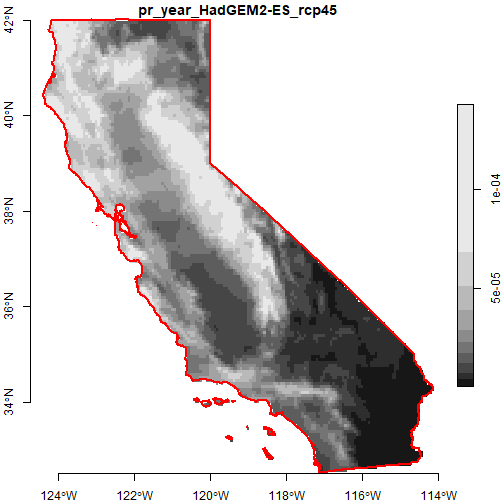
Create a 6D mosaic
Next, we’ll mosaic the 144 3D rasters again, but this time we’ll add
combine_6d = TRUE to tell it we want a single 6D stars
object back:
ca_pryr_blcks_mos_stars <- ca_pryr_blcks_stars_lst %>%
ca_stars_mosaic(geom_mask = ca_bnd_sf, combine_6d = TRUE)
#> - mosaicing 18 stars rasters for pr_year_HadGEM2-ES_rcp45
#> - mosaicing 18 stars rasters for pr_year_CNRM-CM5_rcp45
#> - mosaicing 18 stars rasters for pr_year_CanESM2_rcp45
#> - mosaicing 18 stars rasters for pr_year_MIROC5_rcp45
#> - mosaicing 18 stars rasters for pr_year_HadGEM2-ES_rcp85
#> - mosaicing 18 stars rasters for pr_year_CNRM-CM5_rcp85
#> - mosaicing 18 stars rasters for pr_year_CanESM2_rcp85
#> - mosaicing 18 stars rasters for pr_year_MIROC5_rcp85
ca_pryr_blcks_mos_stars
#> stars object with 6 dimensions and 1 attribute
#> attribute(s), summary of first 1e+05 cells:
#> Min. 1st Qu. Median Mean 3rd Qu. Max. NA's
#> val 2.348845e-07 9.056052e-06 2.114469e-05 2.904023e-05 4.29896e-05 0.0001875527 57527
#> dimension(s):
#> from to offset delta refsys values x/y
#> x 1 165 -124.4 0.0625 WGS 84 NULL [x]
#> y 1 153 42.06 -0.0625 WGS 84 NULL [y]
#> scenario 1 2 NA NA NA rcp45, rcp85
#> gcm 1 4 NA NA NA HadGEM2-ES,...,MIROC5
#> year 1 50 2050 1 NA NULL
#> cvar 1 1 NA NA NA prFor further discussion and examples of working with 6D climate cubes, see the Rasters Part 2 vignette.
Compute the inter-annual variance in precipitation. One of the potential impacts of climate change is increased variability in precipitation. This calculation will tell us relatively speaking which parts of the state may experience more inter-annual variance in precipitation from 2050-2099.
(ca_pryr_sd_stars <- ca_pryr_blcks_mos_stars %>%
st_apply(MARGIN = c("x", "y", "scenario", "gcm", "cvar"),
FUN = sd))
#> stars object with 5 dimensions and 1 attribute
#> attribute(s):
#> Min. 1st Qu. Median Mean 3rd Qu. Max. NA's
#> sd 5.237296e-07 2.693959e-06 5.454798e-06 7.165256e-06 1.023519e-05 4.661779e-05 116688
#> dimension(s):
#> from to offset delta refsys values x/y
#> x 1 165 -124.4 0.0625 WGS 84 NULL [x]
#> y 1 153 42.06 -0.0625 WGS 84 NULL [y]
#> scenario 1 2 NA NA NA rcp45, rcp85
#> gcm 1 4 NA NA NA HadGEM2-ES,...,MIROC5
#> cvar 1 1 NA NA NA prWe can plot the results by GCM for one emissions scenario.
TIP: Note the use of adrop() below, which
drops all dimensions with a range of 1. This is useful in this case
because the stars plot()
function creates subplots for each level of the first
non-spatial dimension. Therefore we want to get rid of all non-spatial
dimensions that have a range of 1 (like cvar and scenario), so that
subplots will be made for the first remaining dimension that has
multiple values (in this case GCM).
plot(ca_pryr_sd_stars %>% filter(scenario == "rcp85") %>% adrop(),
main = "StdDev Annual Precip | RCP85 |")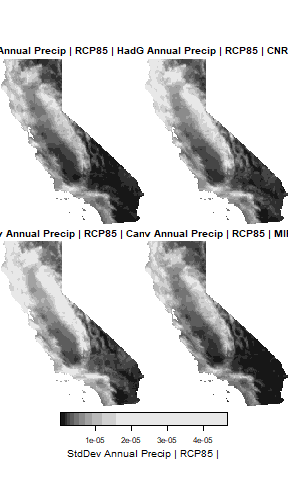
Parallel Processing
st_apply() supports parallelization thru the parallel package, which comes with base R.
Parallelization splits the work among different cores on your computer
(most computers these days have multipore cores). This can improve
performance for pixelwise operations, particularly when the aggregation
function is computationally intensive (more
info).
Let’s compare the amount of time it takes to compute the standard deviation of inter-annual precipitation, with and without parallelization, on a computer that can bring 6 cores into service:
## Without parallelization
system.time(ca_pryr_blcks_mos_stars %>%
st_apply(MARGIN = c("x", "y", "scenario", "gcm", "cvar"),
FUN = sd))
#> user system elapsed
#> 1.83 0.00 1.86
## With parallelization
library(parallel)
my_clust <- makeCluster(6)
system.time(ca_pryr_blcks_mos_stars %>%
st_apply(MARGIN = c("x", "y", "scenario", "gcm", "cvar"),
FUN = sd,
CLUSTER = my_clust))
#> user system elapsed
#> 0.56 0.41 1.15
stopCluster(my_clust)